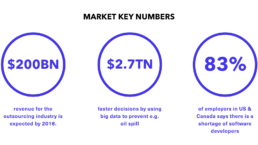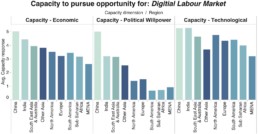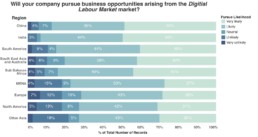Opportunities for employment are not evenly distributed, but digital platforms can connect talent with jobs. They open a whole new perspective to be able to create work for unemployed youth through access to the internet.
Connecting talent with jobs can be one of the most profitable undertakings for the employer, the employee and society. Unfortunately, neither talent nor opportunities for employment are distributed evenly or even in a predictable manner. It can be difficult to find the right match between an open position and a jobseeker.
Digital platforms can aid in connecting talent with jobs across geographic and sectorial borders. For the millions of unemployed youths globally, it opens a whole new perspective for seeking and landing jobs. By creating better matches or simply making matches possible, digital platforms can actually cause more positions to get filled. Estimates say that digital talent platforms can increase employment by 72 million full-time-equivalent positions today, and up to 540 million individuals could benefit from online talent platforms by 2025.

Impact Sourcing
Matchmaking of business and talent through online talent platforms is just one aspect of a digital labor market. Another avenue is the rising business practice of impact sourcing – bringing jobs to otherwise disadvantaged youth. Offshoring is not a new phenomenon, neither is global talent hunting, but a new way of doing it is emerging where companies hire and train unemployed youth in, for example, Africa to become highly skilled potential remote employees. Companies are starting to seek to create jobs with social impact through intentionally employing people with limited opportunities, often in low-income areas.
Part of impact sourcing is up-skilling. It is a triple-win opportunity where the human capital of a country is strengthened, where business gets a job done and where youth is offered a way out of poverty. A new form of impact sourcing is emerging where recruitment companies engage in significant upskilling of disadvantaged youth whom they then connect with potential employers on the outlook for those particular skills. This approach turns the risk of a wasted generation in Africa into an opportunity to upskill unemployed youth while helping to develop a global talent pipeline for businesses.
IT Farm Jobs
Micro work is yet another avenue for youth to enter the labor market aided by digital tools. Platforms are emerging which break down projects into small tasks to be solved by youths on a smart phone or a computer in exchange for money. Micro work can supplement income for youth in informal employment or agriculture and can lead to new skills and new job opportunities.
Most job opportunities generated by impact sourcing are targeted to urban youth. However, the right infrastructure and training can unleash a huge opportunity for job creation and growth by digitizing the rural youth. IT-trained rural populations (even a modest 10 percent) would be a resource, as this skilled labor along with other qualifications can be integrated quickly into newer types of job opportunities, which are opening up, including call centers, backend accounting and legal services. Bringing digital jobs to rural areas can help diversify the economy of agricultural communities and offer youth opportunities close to the family rather than having to migrate to urban areas or aboard in search for employment.
Finally, youth are creating their own digital jobs by building personal brands on digital social platforms. Here a large number of followers or likes can translate into a paycheck and a stronger position from which to negotiate contracts with companies. It is a path to a digital job.
Survey Findings
Using digital technology as a road to job creation for youth has been assessed by the respondents of our 2015 global survey to be the best opportunity to address the risk of a wasted generation to unemployment.

The popularity of this market opportunity sends a strong message that opportunities to address the risk of a wasted generation will have great societal benefits. In the South America and Other Asia regions, in particular, survey respondents have rated this opportunity very positively. In South America, the market opportunity could be even greater if the perceived capacity to pursue it was higher. The market opportunity is also popular among the respondents from South East Asia & Australia.
Affected businesses are the most likely to support this opportunity, which can be explained by the fact that it can secure global access to talents. It is also very popular among young respondents whereas the older segments of the population are not so enthusiastic.

Across all business sectors represented in the survey, this is the market opportunity they are most likely to pursue of all the opportunities assessed in 2015. It is also the opportunity that the service and manufacturing sectors are most likely to pursue. All business sectors have also assessed it to be affecting their business area.
For countries in the high HDI category it is a preferred opportunity with respect to societal benefits and it is among the favorites for the medium HDI countries as well.
This market was surveyed globally in 2015 by more than 5500 leaders from both the public and private sectors. The survey was conducted in collaboration with the research company YouGov. The survey results were originally published in the Global Opportunity Report 2016.

